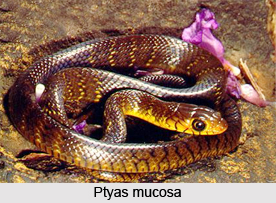 Ptyas Mucosa is an Indian reptile which is commonly known as the oriental rat snake, and it is a common species of colubrid snake found in parts of South and Southeast Asia.
Ptyas Mucosa is an Indian reptile which is commonly known as the oriental rat snake, and it is a common species of colubrid snake found in parts of South and Southeast Asia.
Size of Ptyas Mucosa
Ptyas Mucosas is a large snake growing to 2 m (6.6 ft) and occasionally even to 3 m (9.8 ft).
Colour of Ptyas Mucosa
The colour of Ptyas Mucosa varies from pale browns in dry regions to nearly black in moist forest areas.
Structure of Ptyas Mucosa
Ptyas Mucosas are diurnal, semi-arboreal, non-venomous, and fast-moving.
Feeding of Ptyas Mucosa
Ptyas Mucosas eat a variety of prey and are frequently found in urban areas where rodents thrive.
Naming of Ptyas Mucosa
Ptyas Mucosa is also known as Deshal darash sap in Bengali language, geradiya in Sri Lanka and Ngu Sing Hang Lai in Thai language in Thailand, Jerothana, Jerri pothu or Joru pothu inTelugu language, Sara paambu in Tamil language.
Concentration of Ptyas Mucosa
Ptyas Mucosa is found mostly in Afghanistan, Bangladesh, Burma, Myanmar, Cambodia, China, Zhejiang, Hubei, Jiangxi, Fujian, Guangdong, Hainan, Guangxi, Yunnan, Tibet, Hong Kong), India, Sri Lanka, Indonesia (Sumatra, Java), Iran, Laos, West Malaysia, Nepal, Myanmar, Pakistan, Taiwan, Thailand, Turkmenistan and Vietnam.
Adult Ptyas Mucosa
Ptyas Mucosa has few natural enemies other than the king cobras that overlap them in range. Juveniles fear birds of prey, larger reptiles and mid-sized mammals. They are wary, quick to react and fast-moving.
Hunting of Ptyas mucosa
Ptyas Mucosa and related colubrids are aggressively hunted by humans in some areas of their range for skins and meat. The harvesting and trade regulations exist in China and Indonesia but these often go ignored.
Colour of Ptyas Mucosa
Ptyas Mucosas are brown in colour. It is frequently found with more or less distinct black cross bands on the posterior part of the body and on the tail. The young Ptyas Mucosas are usually with light crossbands on the front half of the body. The lower surfaces of Ptyas Mucosa are yellowish; the posterior ventral and the caudal shields may be edged with black.
Nature of Ptyas Mucosa
Ptyas Mucosas are harmless to humans. Ptyas Mucosas are fast-moving, excitable snakes. In captivity individuals remain highly territorial and may continue to defend their turf aggressively, attempting to startle or strike at passing objects. Ptyas Mucosas are diurnal and semi-arboreal.
Habitat of Ptyas Mucosas
Ptyas Mucosas inhabit forest floors, wetlands, rice paddies, farmland, and suburban areas where they prey upon small reptiles, amphibians, birds, and mammals. Adults, unusually for a colubrid, prefer to subdue their prey by sitting on it rather than by constricting, using body weight to weaken prey.
Breeding of Ptyas Mucosas
Ptyas Mucosas mate in late spring and early summer, though in tropical areas reproduction may take place year round. The male Ptyas Mucosas establish boundaries of territory using a ritualised test of strength in which they intertwine their bodies. The behaviour is sometime misread by observers as a `mating dance` between opposite-sex individuals. The females produce 6-15 eggs per clutch several weeks after mating.
Call of Ptyas Mucosas
The adult members of Ptyas Mucosas emit a growling sound and inflate their necks when threatened. This adaptation may represent mimicry of the king cobra or Indian cobra which overlaps this species in range.
Nomenclature of Ptyas Mucosas
The International Code for Zoological Nomenclature (ICZN) directs that the grammatical gender of any given species name should follow logically from the gender of its associated genus name. As Ptyas Mucosas is a feminine word form, the proper form of the species name is mucosa. Reference materials older than 2004 often show the masculine form, mucosus and the CITES list continues to list the species this way.



















